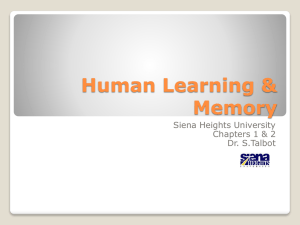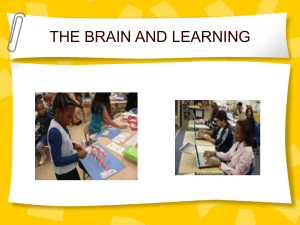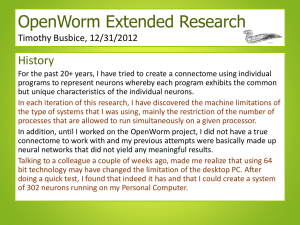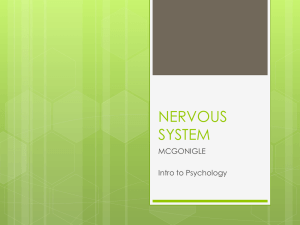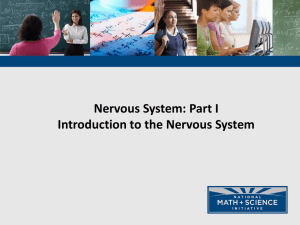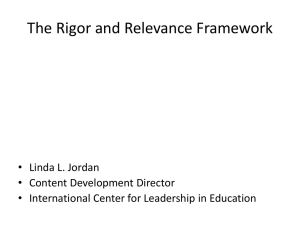Brain Development and Behavior
advertisement
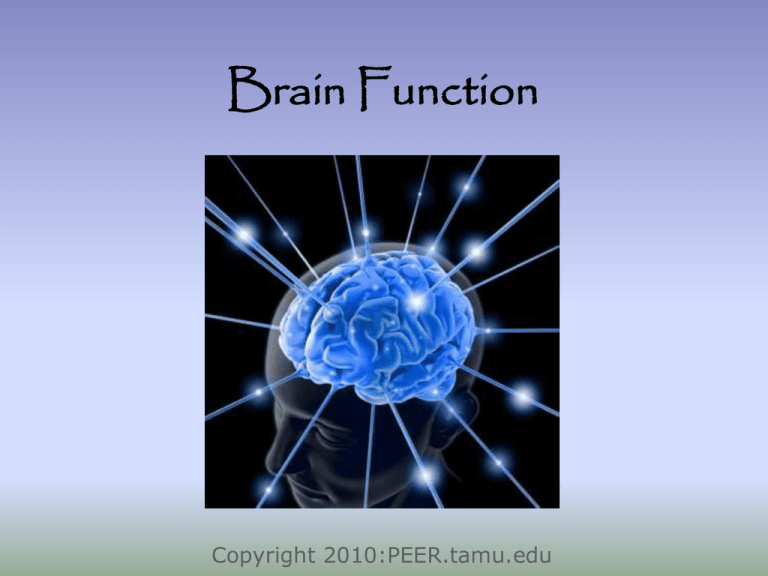
Brain Function Copyright 2010:PEER.tamu.edu We Will Discuss: • How the brain operates. • What nerve cells (neurons) are and what they do. • What the different parts of the brain do. • How the brain creates “three minds”. • Healthy Brain How The Brain Operates Brains are designed as a control system for the body. As with any control system, it has to have sensors to know what is going on and has to have ways of evaluating information making decisions and then issuing commands. Class Discussion: What are some things you think your brain tells you to do? The Brain is an Information Processor: (subconscious processing) Internal vs. External Stimulus What Is a Stimulus??? 1. 3. 2. 6. 4. 5. Neuron Function Nerve Cells are Called Neurons When neurons are active, as they almost always are even when you sleep, they do two things: – generate electrical pulses – release chemical secretions dendrites (input) cell body and nucleus Direction of impulse and information flow axon dendrites (terminal) How NEURONS Take in Information and Process it! Neuron Signaling is the term used to describe the process of neurons passing information back and forth to one another. Neurons have the ability to pass intracellular information (within the cell) and intercellular information (from one cell to another cell). Speedy Processing Continued: • Neurons pass information from cell to cell (intercellular) at synapses through neurotransmission. – communication between neurons is accomplished by the movement of chemicals or electrical signals across a synapse. – A synapse occurs where a axon of one neuron passes information to an dendrite of another neuron. How Neurons Have Evolved for Speedy Processing: • Neurons communicate within the cell (intracellular) through conduction. – Conduction is when an electrical signal generated near the cell body of a neuron moves along the axon to the axon terminals. – Ions are the electrically charged particles moving within the neuron. Electrical signals are used to represent, distribute and process information. Chemical Signals: Above: This picture shows 3 different neurons all transmitting information. Yellow axon to blue dendrite, blue axon to pink dendrite is one way to look at it. An axon to dendrite passage of information represents the passing of chemical signals. Chemical signals help form memories. Neurons Excrete Chemicals • Some neurons excrete chemicals called hormones into the blood stream • Most neurons secrete chemicals directly on each other or on muscle cell targets. – The chemicals acts as messengers (neurotransmitters) to convey information from one neuron to others. • Chemicals released vary with different parts of the brain. • Over 100 chemical secretions have been found in nerve tissue Brain Chemicals • Neurotransmitters – excite – inhibit – modulate (create a bias for being excited or inhibited) • Hormones – Excite neurons (make them fire impulses) – Inhibit neurons (reduce impulse firing) – Change the sensitivity of neurons (make them more or less responsive to other chemicals or electrical input) Neurochemical Transmission Packets of chemicals are released at the axon terminal. Drugs that affect the brain typically act on one or more of these processes. Neurochemical Transmission Receptors Nervous System vs. Electricity How It is Different • Current carried by ions, not electrons. • Current flows as pulses, not continuous. • Current is continuous in the junctions between neurons. • Can travel in many different directions at once. • Chemical and electrical transmitters specifies different kinds of information being passed. • Not rigid like solid electrical curcuits. Lets Discuss: Can you think of some advantages of a processing and communicating system (the brain) operating this way? How does the brain differ from how computers work? That is, how is the transfer of communication different between elements in a computer and neurons in the brain? Brains Operate on the Nerveimpulse Representation of the World, Not the World Itself Think about that! Function of Different Parts of the Brain Spinal Cord There is a central "H" zone containing millions of neurons • It is surrounded by white substance, which is many nerve fibers (axons). • Some fiber bundles go to the brain, while others are bringing information to the spinal cord from the brain. Spinal Cord • Two Way Wiring: Like electrical wiring in your car or your house, neurons in the spinal cord communicate with the brain by insulated cables. • Example: pain information excites neurons to activate muscles that flex the hip and knee of the leg on the same side as the stimulus. Pain information is carried in fiber bundles in the lateral part of the cord. The pathway has relays in the brainstem and thalamus before reaching the cortex. Common pain killer drugs act at different levels of the pathway. Brainstem Note that human brainstem is about the diameter of a pencil. deep in the brain – leads to the spinal cord Functions: Breathing, Heart Rate, Swallowing, Reflexes to seeing and hearing (startle response), Controls sweating, blood pressure, digestion, temperature (autonomic nervous system), Affects level of alertness Ability to sleep, Sense of balance (vestibular function). Cerebrum The biggest part of the brain is the cerebrum. The cerebrum makes up 85% of the brain's weight, and it's easy to see why. The cerebrum is the thinking part of the brain and it controls your voluntary muscles — the ones that move when you want them to. So you can't dance — or kick a soccer ball — without your cerebrum. Your memory lives in the cerebrum — both short-term memory (what you ate for dinner last night) and longterm memory (the name of that roller-coaster you rode on two summers ago). When you're thinking hard, you're using your cerebrum. You need it to solve math problems, figure out a video game, and draw a picture. Cerebrum Continued: The cerebrum also helps you reason, like when you figure out that you'd better do your homework now because your mom is taking you to a movie later. The left half is said to be more analytical, helping you with The cerebrum has math, logic, and speech. two halves, with one on either side Scientists do know for sure that of the head. the right half of the cerebrum controls the left side of your Some scientists think that body, and the left half controls the right half helps you the right side think about abstract things like music, colors, and shapes. Frontal Lobe: Most anterior, right under the forehead Functions: How we know what we are doing within our environment (consciousness) How we initiate activity in response to our environment Judgments we make about what occurs in our daily activities Controls our emotional response Controls our speaking language Memory for habits and motor activities Parietal Lobe: Functions: Location for visual attention and touch perception. Goal-directed, voluntary movements. Manipulation of objects. Integration of different senses that allows for understanding a single concept. Near the back and top of the head Occipital Lobe: Most posterior, at the back of the head Functions: Vision Temporal Lobe: Side of head above ears Functions: Hearing ability Memory acquisition Some visual perceptions Categorization of objects Cerebellum Gold colored area located at the base of the skull. Functions: Coordination of voluntary movement Balance and equilibrium Some memory for reflex motor acts The Brain Makes Us Aware • Humans have detector cells for: – – – – – – Light waves (eyes) Sound waves (ears) Chemicals that we smell (sensors in the nose) Chemicals that we taste (tongue sensors) Physical forces (touch, pressure, cold, heat) (skin sensors) Muscle tone and limb position (sensors in muscles) Humans can be consciously aware of many of these stimuli. We not only know this information, we are aware that we are aware of it. The “Reptilian” Brain “Reptilian” Brain Functions • Mostly controlled by brainstem structures found in all animals (even fish) • Interaction with spinal reflexes • Control over neurohormone systems (pituitary gland) • Control over automated movements • Activation of the rest of brain in response to stimulation The Brain Makes Us Feel Emotions • Some of the same structures used in emotions are also involved in memory formation. The Limbic System • Controls emotions • Controls formation of certain kinds of long-term memories • The limbic system is a complex set of structures that lies on both sides of the thalamus, just under the cerebrum. It includes the hypothalamus, the hippocampus, the amygdala, and several other nearby areas. In primitive mammal brain, most of the brain is the limbic system. OB = olfactory bulb, HIP = hippocampus, AC = anterior commissure (fiber tract connecting olfactory structures), V – ventricles (cavity), NC = neocortex, but most of this is really limbic cortex. Memory • Memories are stored widely in the brain. • The medial temporal lobe and nearby structures, are responsible for converting temporary memories into more permanent form. Ventral view of brain. Temporal lobe is outlined in white. * indicates the visible part of hippocampus. Hippocampus Consolidates Memory • Located in area beneath the ears (medial temporal lobe) • Consolidation: temporary memories into more permanent form. Memory “Consolidation” • This conversion has certain requirements: – The brain needs to pay attention so that the information actually registers in the first place – Motivation to remember helps – Time must elapse (seconds to minutes) – Distractions and other stimuli should be kept to a minimum, because they will otherwise interfere with the conversion process Class Discussion: how do these ideas apply to learning effectively in school? Cool Link Break! The following link is helpful and useful for kids to see and hear about the brain: http://kidshealth.org/misc/movie/bodybasics/bod ybasics_brain.html What Sets Us Apart? The cerebral cortex or neocortex is what makes us human. The cerebral cortex is the layer of the brain often referred to as gray matter. The cortex (thin layer of tissue) is gray because nerves in this area lack the insulation that makes most other parts of the brain appear to be white. The cortex covers the outer portion the cerebrum and cerebellum. The human cerebral cortex is 2– 4 mm (0.08–0.16 inches) thick. It is this outer layer that gives us the ability to think, to make choices, and to reflect on our emotions rather than unthinkingly act on them. “Wiring Diagram of Cerebral Cortex This is what makes us different • Six layers of cells surrounding the rest of brain. – Other mammals have such cells, but not as many layers and not so many. – Cells organized vertically, as columns Area A and B, outer layer 6: mostly all fibers. Circles labeled L are cell bodies in different layers. “Thal” and “Sub” refer the cells in the thalamus and subthalamus that send inputs to the columns. Circuit diagram of one column… connects with adjacent columns. Humans Are Unique • What motivates you? – The desire for pleasurable sensations and experiences – The desire to avoid unpleasant sensations and experiences • Laughter is one clear difference humans have from animals • Likewise, emotion-based crying seems unique to humans. The Brain Is the Organ of Personality • Teenage brains are rapidly changing, sculpted by experience • Social environment and thoughts will affect that sculpting. • The most profound changes occur in the front of the brain, the part that is crucial for advanced functions such as critical thinking, self-control, and judgment. • The frontal cortex does not mature until about age 25. Importance of Technology: The Oscilloscope The electricity in a nerve involves such a small amount of current that it has to be made bigger and displayed by a TV-like instrument called an oscilloscope. Voltage changes deflect the beam moving across the screen Brain Waves • Currents in the part of the brain nearest to the scalp are large enough to be detected with electrodes • This electrical activity is small (on the order of 10 to 50 millionths of a volt). Brain Creates Mind Actually Three Minds • Unconscious: spinal and brainstem reflexes, hormone controls • Subconscious: emotions, wellestablished memories • Conscious: newly forming memories, self awareness Your brain has a mind of its own Brain affects mind. Mind affects brain. Brain affects behavior and hormone release. Where Does Consciousness Come From? It comes from the interaction between: – the cerebral cortex (outer part of the brain) – a cluster of cells in the core of the brainstem • Lower animals have many fewer cells in their cortex than us. • Therefore, they cannot operate at the same high level of consciousness as we do. Improving Your Mind • You can train your brain to have certain attitudes, beliefs, capabilities. • You can abuse your brain by feeding it bad ideas, unhealthy ideas, or drugs that affect the mind. • Feeding junk ideas, information, and feelings to your brain can affect your brain and behavior permanently. Improving Your Mind, cont. • Brains affect behavior. • But behavior (and thoughts that control behavior) affect the brain. Let’s Discuss: Can we blame our bad brains for our bad behavior and thoughts? Or is that just an excuse for our failure to make better behavior choices? Be Good to Your Brain What can you do for your brain? • Eat healthy foods. – They contain potassium and calcium, two minerals that are important for the nervous system. • Get a lot of playtime (exercise). • Wear a helmet when you ride your bike or play other sports that require head protection. • Don't drink alcohol, take drugs, or use tobacco. • Use your brain by doing challenging activities\ – such as puzzles, reading, playing music, making art, or anything else that gives your brain a workout Do you want your brain to look like this? or This? Brain Function: Conclusion • Remember, mistreating your brain can permanently alter the way you learn, feel rewarded, and store memories. • Keep your brain healthy through proper nutrition to support neuron development and by training yourself to have positive attitudes, beliefs, capabilities!



